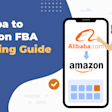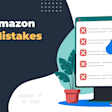
How to Handle Amazon FBA Returns: Smart Strategies for Sellers
Returns: The word no Amazon seller wants to hear, but every FBA business must face. Whether you're a seasoned vendor or just getting your feet wet in the marketplace, understanding how Amazon FBA returns work is crucial to protecting your bottom line. With Amazon's customer-first return policy and ever-evolving fulfillment rules, managing returns isn’t just about reacting—it’s about strategy. In this practical guide, we’ll demystify the process of Amazon manage returns, break down the fees, and share proven ways to reduce your return rate.
Table of contents
How Amazon FBA Returns Work
If you sell on Amazon, returns aren’t just a possibility, they’re a standard part of any business. Thanks to Amazon’s customer-friendly return policy, buyers can usually send products back with little friction, especially when the order is fulfilled by Amazon (FBA). When a customer initiates a return, Amazon handles the entire process, from issuing a label to restocking or disposing of the item, all through Amazon’s Manage Returns system. While the process is fairly seamless for the buyer but can feel like a black box for the seller. And yes, return-related fees can quietly chip away at your profit margins if you’re not paying attention.
Not All Returns Are Treated Equally
Once a product is returned, Amazon inspects it and places it into one of several categories:
Sellable – Unopened and unused; returned to inventory
Damaged – Visibly broken or compromised
Customer Damaged – Used or altered by the buyer
Carrier Damaged – Damaged during shipping
Unsellable – Not suitable for resale and still subject to removal fees
Each classification determines what happens next: the item goes back into your inventory, is discarded, or possibly reimbursed.
What Happens at the Fulfillment Center
If the item is considered sellable, Amazon will simply restock it into your FBA inventory. If it’s unsellable but eligible for reimbursement (for example, if it was carrier-damaged), you may receive partial compensation. Otherwise, you’re responsible for paying removal or disposal fees.
Some sellers also deal with return abuse, which happens when customers send back used, damaged, or even swapped-out items. Unfortunately, Amazon’s generous return policy often leaves little room for dispute in these cases.
Why Return Rates Matter
Returns don’t just affect your profitability - they can also impact the overall health of yoaccount on Amazon. High return rates are often tied to negative customer feedback and can lead to consequences such as:
Lower product rankings
Suppressed listings
In serious cases, account suspension
Amazon tracks performance metrics across both FBA and FBM (Fulfilled by Merchant), including:
Order defect rate
Return dissatisfaction rate
Fulfillment-related issues
Even though returns are an unavoidable part of selling on Amazon, they don’t have to be a blind spot. By understanding how FBA returns work and staying on top of return-related costs and metrics, you can protect your margins and your account.
Managing and Reducing Returns
Here’s the truth: most Amazon FBA returns are preventable. Many sellers often chalk them up to bad luck or picky Prime customers, but in reality, a lot of it comes down to prep, presentation, and paying attention to buyer feedback. The good news? You have more control than you think. Managing Amazon returns starts long before your product ever reaches a customer - it begins at your warehouse.
First, make the quality of your product a priority. Before you ship any inventory to an Amazon fulfillment center, inspect it like your business depends on it - because it does. Damaged, defective, or inconsistent items are a surefire way to rack up returns, lose customer trust, and endanger the health of your seller account. Double-check the packaging, test the product’s functionality, and ensure consistency across batches. If you're sourcing from overseas vendors, consider a third-party inspection service to catch any potential problems before they become Amazon FBA return nightmares.
Next, take a look at your reviews, and your competitors’. Customer feedback is a goldmine of insight into what’s working and what’s not. One smart way to dig deep is by using the AI Review Analyzer from AMZScout. It’s fast, easy, and helps you make data-backed decisions:
Go to the AI Review Analyzer page. Enter your email address to activate a free trial, which includes one free product check.
Enter the product’s ASIN and click “Analyze Product by ASIN.”
View custom insights presented through graphs, stats, and text summaries pulled straight from customer reviews.
These insights reveal common complaints, highlight top praise points, and show you what customers really care about, whether it's faulty zippers, unclear instructions, or confusing sizing. This enables you to update your product, packaging, or customer messaging accordingly to address those issues head-on.
Now let’s talk about listings, because the wrong expectations lead to the negative reviews. Your product page is your digital storefront so make it count. Use high-quality images taken from multiple angles, clear and honest bullet points, and a keyword-optimized description that sets accurate expectations.
Not a wordsmith? No problem. AMZScout’s AI Listing Builder makes this part easy. Upload the results from the Review Analyzer and generate polished, customer-friendly text in seconds, tailored to your product and its real-world feedback.
When you combine higher product quality, sharper listings, and smarter feedback analysis, you’re not just managing returns, you’re reducing them. This is the difference between treading water and scaling a thriving Amazon business.


How to Handle Amazon FBA Returns
Let’s be real - returns happen. Even if you follow every tip from the previous section, such as inspecting your products, analyzing reviews, and perfecting your listing, Amazon FBA returns are still part of the game. That’s the trade-off for tapping into Amazon’s vast fulfillment network and its famously generous customer return policy. So even though you can’t prevent every return, you can handle them effectively and minimize the damage to your business.
Start with triage: what came back, and in what condition? If the returned product is undamaged and classified as “sellable”, Amazon will usually repackage and restock it automatically, at no extra cost beyond your usual fees. These items go right back into your inventory so they’re ready for the next customer with no action needed on your part.
But what if it’s not in resellable shape? That’s where Amazon Manage Returns tools—like the Removal Order feature and Disposal Request option—come in. For damaged or customer-used products, you have a couple of options. You can:
Create a removal order to have the item shipped back to you, especially if it’s a high-value item or something you may be able to refurbish and resell through FBM or another channel.
Request disposal if the item isn’t worth salvaging. This is often the cleanest route if the product is broken, unsanitary, or just not worth the shipping cost.
In some cases, Amazon may owe you money. If the item was damaged by Amazon during fulfillment or return transit, or if the customer never sends it back, you may be eligible for a refund or reimbursement. Keep an eye on your FBA reports and reconcile your returns regularly. Mistakes happen, and Amazon doesn’t always reimburse you automatically.
Pro tip: Monitor repeat return offenders. Some customers exploit the system by returning multiple items or swapping them for damaged goods. While Amazon protects the buyer by default, excessive abuse can still be flagged, especially if you document issues and reach out to them through Seller Central support.
Handling returns isn't glamorous, but it's essential for maintaining the health of your account, protecting your margins, and keeping your Amazon marketplace presence strong. When you approach returns with a strategy in place (just like your product sourcing and listing optimization), they become less of a setback and more of a smart business checkpoint.
Final Thoughts
Amazon FBA returns don’t have to be a profit killer. They can be a powerful feedback loop for growth. By staying proactive with quality control, smart listing optimization, and effective return management, you can protect your margins and build a stronger, more resilient business. And with tools like AMZScout at your fingertips, turning customer feedback into actionable improvements has never been easier. Stay ahead, stay informed, and let every return move your business forward.






